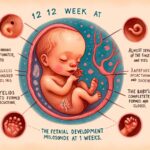Quickening, the moment a mother first feels the movements of her unborn child, is a milestone in pregnancy that is as enchanting as it is significant. It marks a turning point, offering tangible proof of the new life blossoming within. This guide is designed to unfold the mysteries of quickening from a mother’s perspective, offering deep insights into what to expect, when to expect it, and why it matters.
What is Quickening and When Does it Happen?
Quickening refers to the initial moment when a pregnant woman first feels the movements of her fetus. These sensations are often described as flutters or gentle twitches and can be easily confused with hunger pangs or gas. For most expectant mothers, quickening occurs between the 16th and 25th weeks of pregnancy, though it can vary significantly from one person to another.
The timeline for feeling these first movements can depend on several factors, including the mother’s body type, the position of the placenta, and whether it’s the first pregnancy. Typically, women may notice these sensations earlier in subsequent pregnancies than in their first. Understanding the broad timeline can help mothers-to-be attune themselves to their bodies and recognize these first precious flutters of life.
Why is Quickening Significant?
Quickening is more than just a physical sensation; it’s a profound moment of connection between a mother and her unborn child. It’s often the first ‘communication’ from the baby, signaling its growth and vitality. This experience can dramatically enhance the maternal bond and is a reassurance of the pregnancy’s progression.
From a medical standpoint, the onset of fetal movements is a positive sign. It indicates that the baby is active and developing normally. Doctors and healthcare providers may inquire about quickening during prenatal visits as it helps in assessing fetal health. Recognizing the patterns of movement can also be crucial in monitoring the well-being of the baby as the pregnancy progresses.
Quickening (Mother’s Perspective): What Should You Expect?
Each mother’s experience with quickening is unique. The sensations can vary from faint tickles to more pronounced poking or rolling movements as the baby grows. Initially, these movements may be sporadic and difficult to distinguish from other bodily sensations. However, as the pregnancy advances, the movements become stronger and more defined, allowing mothers to learn their baby’s activity patterns.
It’s important to note that while some movements are gentle, others can be quite vigorous, causing surprise or even discomfort. Embracing this variability is part of the journey. Mothers are encouraged to communicate with their healthcare providers about their experiences of quickening and any changes in movement frequency or strength, as this can be an essential indicator of fetal health.
Emotional Impact of Quickening
The emotional journey of quickening is as significant as the physical experience. Feeling the baby move for the first time can evoke a wide range of emotions, from joy and wonder to anxiety about the baby’s well-being. It’s a tangible reminder of the life growing inside, making the pregnancy feel more real than ever before.
For many mothers, these movements are a source of comfort, providing daily reassurance that their baby is active and healthy. They can also spark a deeper contemplation on motherhood and the responsibilities that lie ahead. Sharing these experiences with partners or loved ones can further strengthen familial bonds and provide support throughout the pregnancy journey.
Monitoring and Understanding Baby’s Movements
As the pregnancy progresses, paying attention to the baby’s movements becomes increasingly important. A change in the pattern or frequency of movements can be an early indicator of potential issues that require medical attention. Expectant mothers should track these movements, noting any significant changes, and discuss them with their healthcare provider.
There are tools and techniques to help monitor fetal movements, including counting kicks or using apps designed for this purpose. These methods can help mothers become more attuned to their baby’s activity patterns and detect any abnormalities early. For more information on monitoring fetal movements, visit March of Dimes, which offers detailed guidance and support.
In conclusion, quickening is a milestone that marks a significant phase in the journey of pregnancy. It connects the mother and the baby in a profound way, offering assurance, excitement, and sometimes a bit of worry. Understanding quickening from a mother’s perspective allows for a deeper appreciation of this miraculous time. By staying informed and attentive, mothers can ensure the health and well-being of their unborn child while savoring the joy of each flutter and kick.













